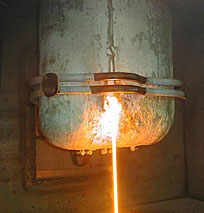Research
Highlights...
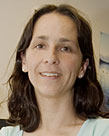
|
Argonne's Mariana Varotto
|
|
 |
Number 241 |
August 13, 2007 |
|
Pairing nanoparticles with proteins
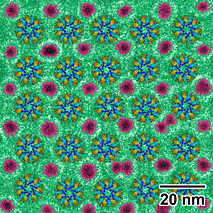 |
| An enzyme-nanoparticle array |
Nanoscience and biology merge at DOE's Brookhaven Lab where scientists have demonstrated the ability to strategically attach gold nanoparticles — particles on the order of billionths of a meter — to proteins in an ordered and predictable way. The nanoparticles and methods to create nanoparticle-protein complexes can be used to help decipher protein structures, to identify functional parts of proteins, and to "glue" together new protein complexes. One resulting structure was sheets of enzyme-gold arrays, which could serve as a model for designing more efficient catalysts for converting biomass to energy. Other potential applications include the design of precision "vehicles" for delivering drugs to specifically targeted cells.
[Karen McNulty Walsh, 631/344-8350,
kmcnulty@bnl.gov] |
|
Exotic beam facility proposed
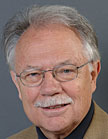 |
| Walter F. Henning |
World-renowned physicist Walter F. Henning is joining the scientific staff at DOE's Argonne National Laboratory to head up Argonne's efforts to build a proposed exotic beam facility for nuclear physics research, which will revolutionize our understanding of nuclei, the core of matter, and the fuel of stars. DOE has proposed to build an exotic beam facility for the next generation of nuclear physics research, and Argonne is one of the sites competing for that facility. A recent National Academy of Sciences report stressed the scientific opportunities that exist with exotic beams. This new facility would provide physicists with energetic, high-quality beams of literally thousands of isotopes of elements in the periodic table, including a great many that have never before been observed on earth.
[Sylvia Carson, 630/252-5510,
scarson@anl.gov] |
|
Scientists pick out pions
A new measurement of the lifetime of the neutral pion conducted at the DOE's Jefferson Lab is twice as precise as the current world value. The result is another step forward in understanding symmetry breaking in nature, a phenomenon that led to the evolution of matter in the early universe. Pions are some of matter¹s simplest particles, built from the same building blocks as protons and neutrons: smaller particles known as quarks. Studying the simple pion and its properties can reveal information about matter in the universe, where it came from and how it¹s held together.
[Kandice Carter, 757/269-7263,
kcarter@jlab.org]
|
|
Beat the heat with Near-Zero-Energy homes
As utilities deal with record summer afternoon electricity demand, a home in Lenoir City, Tenn. is actually selling power back into the system. Instead of contributing to the peak load, a Near-Zero-Energy home is contributing to the solution. Combine super-energy-efficient technologies with the ability—thanks to rooftop solar collectors—to sell back power to the system, and a Near-Zero-Energy home becomes a power supplier. DOE's Oak Ridge National Laboratory has been designing and implementing the Near-Zero Energy Homes concept in conjunction with the Tennessee Valley Authority. The concept is working, in the near-triple-digit heat, in locations such as a Habitat for Humanity community in Lenoir City, Tenn., where the power meters sometimes run backward as the homes generate more energy than they consume.
[Bill Cabage, 865/574-4399,
cabagewh@ornl.gov]
|
|
|
Argonne 's Mariana Varotto honored as role model
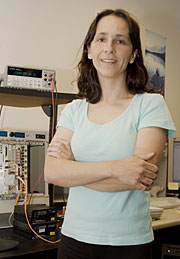 |
Mariana Varotto |
Mariana Varotto of the Controls Group in the APS Engineering and Support Division at DOE's Argonne National Laboratory has been recognized as a role model for technology professionals by HENAAC. HENAAC was established in 1989 as a means of identifying, honoring, and documenting the contributions of outstanding Hispanic American science, engineering, technology, and math professionals.
Marianna plays an integral role in keeping the APS, one of the most technologically complex machines in the world, operational. The APS control systems are diverse including over 260 distributed computers around the facility that provide real-time control and monitoring functions for the technical systems. Mariana is responsible for dozens of applications and is frequently sought out for her expeditious and accurate response to customer requests.
Varotto was nominated by Ned Arnold, Controls Group leader due to her ability to learn about a new technology or system independently and quickly. In a very short time she has made significant contributions to our system software, our relational database applications, and numerous on-line systems that run 24/7.
In addition to her technical capabilities, Mariana has demonstrated a keen interest in promoting engineering and science careers to young women through her involvement in laboratory outreach programs.
According to Varotto, “Working for the Advanced Photon Source … is exciting and challenging every day…Ultimately, our best reward is to know that these x-rays allow scientists to explore the structure and function of materials at a microscopic level; in essence, the frontiers of our known world,” she explains.
Mariana was born and raised in Bahia Blanca, Argentina and is a graduate of the electronic engineering program at Argentina 's Universidad National del Sure. She has been at Argonne for six years, all of them with the Advanced Photon Source. She is married and has a 9-month-old son, Lucas.
Submitted by DOE's
Argonne National Laboratory
|
|





